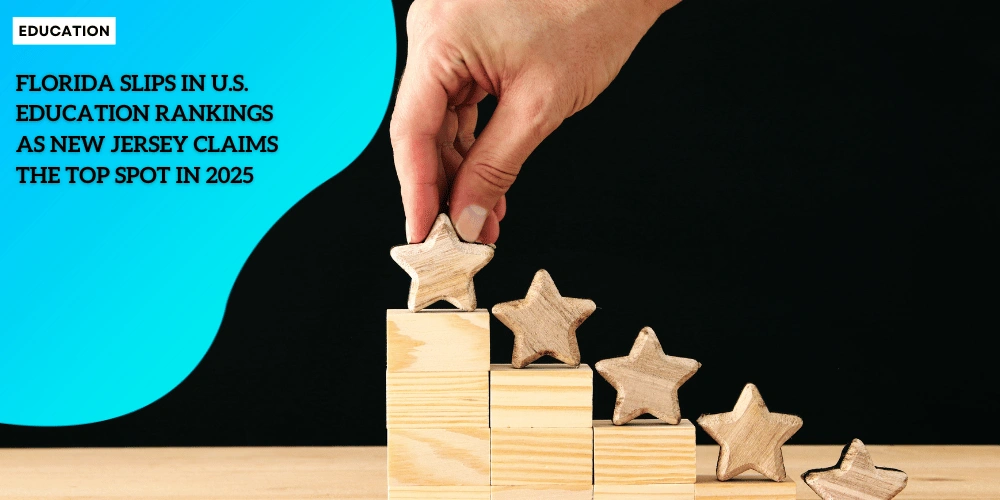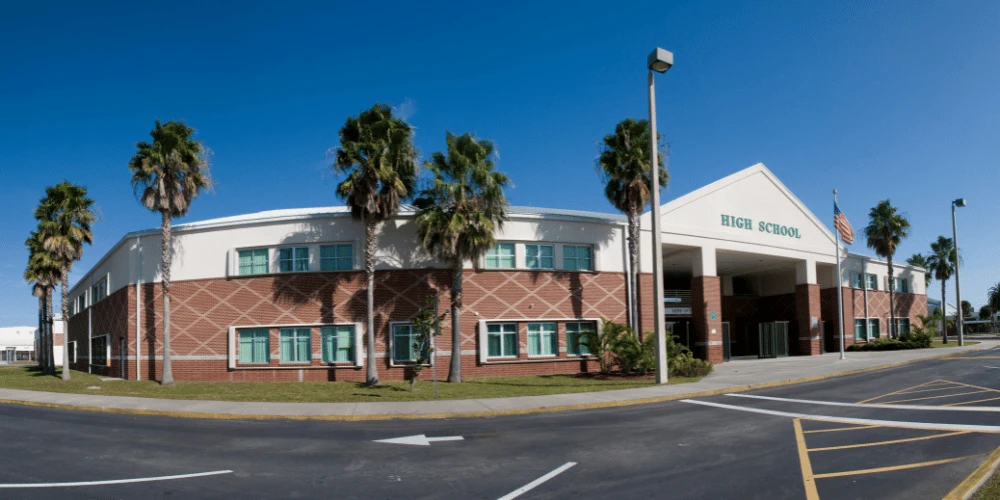Florida Slips in U.S. Education Rankings as New Jersey Claims the Top Spot in 2025

Anúncios
What the Shift Means for American Families, Students, and Policymakers
For two years in a row, Florida held the coveted title of the best state for education in America, topping U.S. News & World Report’s annual Best States rankings.
But in the 2025 edition, that reign came to an end as New Jersey surged ahead to reclaim the No. 1 spot—a shift that reflects deep contrasts between the two states in their approach to education funding, access, and performance at both the K-12 and higher education levels.
Anúncios
Though Florida remains near the top of the list, its slight slip has prompted debate among educators, parents, and policymakers.
Why did New Jersey edge ahead? And what does this shift mean for students and families navigating an increasingly complex educational landscape?
Anúncios
Understanding the Rankings: How States Are Graded on Education
The U.S. News Best States rankings evaluate all 50 states based on 71 metrics across categories such as health care, infrastructure, economy, and public safety.
Education is one of the most heavily weighted categories, and it includes a mix of data covering pre-K through 12th grade (K-12) and higher education.
To measure education quality, U.S. News looks at ten metrics:
-
🏫Five focus on K-12 outcomes like test scores, high school graduation rates, and preschool enrollment.
-
🏫The other five center on higher education affordability, graduation rates, and degree attainment.
In 2025, New Jersey outperformed in nearly every K-12 category, while Florida remained dominant in higher education.
This division tells a powerful story about where each state invests—and what outcomes those investments deliver.
New Jersey: A Pre-K Through 12 Powerhouse
New Jersey earned top rankings in nearly every K-12 metric:
-
🏫No. 1 in preschool enrollment, signaling strong early childhood education access.
-
🏫No. 1 in college readiness, based on SAT/ACT scores and curriculum alignment.
-
🏫Top 3 in high school graduation rates, with some of the nation’s highest completion numbers.
These results stem from consistent investment in public education.
According to the National Education Association (NEA), New Jersey ranks:
-
🏫5th in per-student spending, with $24,831 per student annually.
-
🏫8th in average teacher salary, providing financial stability for experienced educators.
Sean Spiller, president of the New Jersey Education Association (NJEA), attributes the state’s performance to its “strong labor force” of teachers, active parental engagement, and bipartisan state support.
“We’ve got great educators,” Spiller said. “We’ve got students who are engaged. We’ve got parents who are part of that process. We’ve got a state that invests in our school systems.”
Still, New Jersey isn’t without its challenges.
Racial and socioeconomic disparities persist, and low-income students experienced significant learning loss during the pandemic, especially in math.
These factors remain critical policy issues, despite the state’s top ranking.
Florida’s Strength: An Affordable, Efficient Higher Ed System
Where New Jersey dominates in early education, Florida excels in higher education, boasting:
-
🏫The nation’s highest graduation rates from both two-year and four-year public colleges.
-
🏫The most affordable public college tuition in the country—just $4,540 per year for in-state students (excluding room and board).
-
🏫Efficient time-to-degree metrics, with nearly 75% of students completing a bachelor’s degree within six years.
Florida’s public university system, which includes flagship institutions like the University of Florida and Florida State University, is widely considered a national model for affordability and access.
Andrew Spar, president of the Florida Education Association (FEA), praises the state’s achievements in higher ed:
“We have amazing higher ed institutions in Florida,” Spar noted. “Because it is cost-effective and because we do a lot of research and because our faculty has been free to do what they think is best for their students.”
However, Spar also warned that Florida’s success could be at risk due to curriculum restrictions, political interference, and declining research funding, both federally and at the state level.
“If we don’t continue to invest in higher education as we have, then I worry that we will fall behind.”
Florida’s K-12 Struggles: A Teacher Shortage and Stagnant Test Scores
While Florida continues to lead in higher education, it lags behind in K-12 outcomes:
-
🏫The state ranks outside the top 10 in nearly every pre-K through 12 metric.
-
🏫Its eighth-grade standardized test scores place it among the bottom 10 nationwide.
-
🏫A serious teacher shortage is affecting school performance across districts.
The average Florida teacher salary was just under $55,000 in 2023–2024, the lowest in the nation according to NEA data.
At the same time, Florida’s per-student spending was $13,584—nearly $11,000 less than New Jersey’s.
With wages failing to keep pace, many experienced teachers have left the profession, while schools are increasingly reliant on long-term substitutes with limited training or subject matter expertise.
“They’re not getting educated by content experts,” Spar said. “This has a real impact on student achievement.”
The Role of Politics in Education Rankings
Florida’s educational identity has also been shaped by a number of politically charged policies over the past few years.
These include:
-
🏫Book bans and restrictions on certain classroom topics.
-
🏫Legislative actions targeting university autonomy, including leadership overhauls of politically “noncompliant” institutions.
-
🏫Curriculum revisions limiting discussions on race, gender, and U.S. history.
While these policies have garnered national attention, their long-term effects on student outcomes are still being evaluated.
Critics argue that such measures risk discouraging educators and limiting academic freedom, particularly at the university level.
By contrast, New Jersey has embraced a more collaborative and investment-focused approach, prioritizing equity, funding, and teacher support.
This may explain why the state saw broader improvements across its educational system.
What This Means for American Families and Students
The diverging paths of Florida and New Jersey offer a valuable lens for understanding broader trends in American education.
Here’s what families and students across the country should take from the 2025 rankings:
1. Early Investment Pays Off
New Jersey’s pre-K and K-12 success demonstrates the long-term value of investing in early education, high-quality teaching, and curriculum alignment.
These factors drive graduation rates, test performance, and college readiness.
2. Affordability Still Matters
Florida’s top-tier performance in higher ed underscores the importance of college affordability.
In a time of rising tuition and student loan anxiety, low-cost, high-quality institutions give students more flexibility and less debt.
3. Political Stability and Academic Freedom Are Essential
The contrasting political climates in each state reveal how governance affects education.
New Jersey has maintained a stable, union-supported structure that empowers educators.
Florida’s recent education-related controversies could impact student outcomes and institutional reputation long-term.
4. Teacher Support Is Non-Negotiable
Both states highlight the growing need for competitive teacher pay, proper certification, and workforce development.
Teacher shortages remain a national issue and must be addressed with long-term policy solutions.
Looking Ahead: Will Florida Regain the Top Spot?
Florida remains a formidable contender in the national education landscape.
Its public colleges are models of efficiency and affordability, and it still ranks among the top ten states overall.
However, if the state fails to address its growing K-12 challenges—teacher shortages, low funding, and academic performance—it may fall further in future rankings.
New Jersey’s ascent shows that comprehensive investment across all levels of education, from preschool to public universities, is necessary to secure long-term educational excellence.
For both states—and indeed the entire country—the 2025 Best States rankings offer more than just bragging rights.
They represent a call to action for leaders, educators, and families to think strategically about what kind of educational system they want to build, and who they want it to serve.
Conclusion: Two Education Models, One National Lesson
The story of Florida and New Jersey in 2025 is more than a shuffle in the rankings.
It’s a reflection of two distinct philosophies on how to deliver educational excellence—one focused on higher ed affordability and efficiency, the other rooted in strong public school foundations and teacher empowerment.
For American families deciding where to live, for students weighing college decisions, and for policymakers tasked with shaping the future of public education, the message is clear: the choices we make today—on funding, policy, equity, and freedom—will define the educational outcomes of tomorrow.







